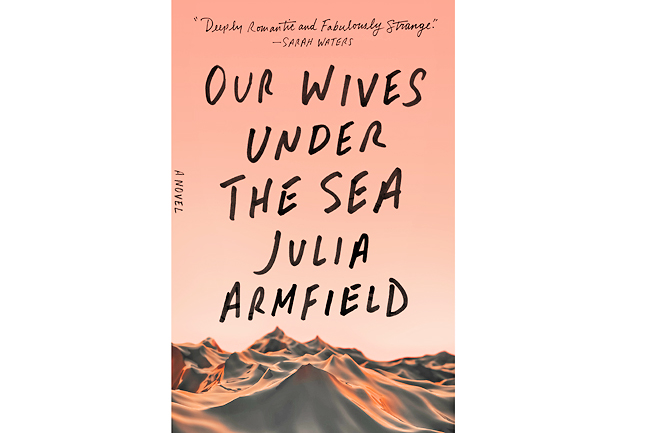THE WASHINGTON POST – Lovers drift apart.
Nothing could be more ordinary. But that common tale of woe feels shocking in Julia Armfield’s debut novel, Our Wives Under the Sea.
The very first line of her exceedingly moody story warns us to expect the unexpected: “The deep sea is a haunted house,” Armfield wrote, “a place in which things that ought not to exist move about in the darkness”.
And yet even that gothic portent can’t prepare us for what lies beneath the surface of this queer romance.
In one sense, the plot is simple, even daringly static.
Two young women are stuck in their apartment, where they will remain almost until the end of the novel.
Leah works as a marine biologist, and Miri writes grant applications, but their normal lives have been entirely suspended.
When the novel opens, Miri is caring for Leah, who’s just returned from a deep-sea disaster.
We learn that a three-week research mission went horribly awry and dragged out over six hope-crushing months before she was unexpectedly rescued.

During that period of worry and arrested grief, Miri fantasised about joining a support group for people with missing spouses: “Wife Under the Sea? Here’s the Number to Call.”
But in practice, Miri did nothing but ruminate, despair and resent the world’s blithe continuance.
Now, as Leah recuperates, Miri is stuck dialing and redialing the mission administrator to find out what exactly happened to her debilitated wife on the ocean floor.
She waits endlessly on hold, gets cut off – rinse, repeat. With her often achingly poetic style, Miri admits, “My heart is a thin thing, these days – shred of paper blown between the spaces in my ribs.”
Our Wives Under the Sea is presented as a series of short chapters narrated alternately by these two lovers.
For Miri, the act of nursing excites profound feelings of hypochondria and dread, exacerbating the sorrow she’s still feeling from the loss of her mother.
But what troubles her even more is the swelling sense of separation from Leah.
“I have found myself trying to escape this new lack between us,” Miri confessed, “grown conscientious about my running, lingering hours in the supermarket, pointlessly deliberating over brands of detergent, scrutinising tubs of yoghurt and butter and butter substitute. Occasionally, I will tell Leah I’m leaving the flat to complete a specific activity and instead simply walk to some fixed point and stand there until I get bored enough to return.”
That reference to boredom gives some indication of the trouble in this relationship – and the risks that Armfield’s ruminative story takes. After all, this is a novel in which one of the narrators said, “For a long time nothing happened,” and she means it.
There is little movement here in the fetid atmosphere that drifts between convalescence and hospice.
But Armfield exercises an exquisite – even sadistic – sense of suspense. She’s cleverly designed this story so that we only gradually become aware of how little we know.
There’s more than a drop of The Turn of the Screw in these pages – a fungal terror that spreads by sustained vagueness. Each of Miri’s chapters fills in some fresh and alarming detail about Leah’s symptoms.
We know that she was discharged and sent home with nothing except a white noise machine, a pair of decompression socks and a book of aphorisms, but Miri senses something more complicated happened and is still happening to her spouse.
It’s not just Leah’s chronic fatigue; she’s bleeding from her gums, and her skin has taken on a peculiar sheen.
“She is silvered over,” Miri said, “oystered at her elbow creases and around the neck.”
Increasingly taciturn, remote and irritated, Leah spends so much time in the bathtub that their water bill skyrockets.
“It isn’t that her being back is difficult,” Miri said, “it’s that I’m not convinced she’s really back at all.” And with that, almost imperceptibly, the story slithers from a love story to a Lovecraft story.
Meanwhile, in Leah’s chapters, the details of that disastrous deep-sea mission begin to accrete, sharp and beautiful as coral polyps. “It is actually very rare for a submarine to sink,” Leah reassured us.
But that’s exactly what transpired early in her mission when the vessel’s electrical system partially shut down.
“Our craft seemed suddenly less a piece of precision-tooled engineering and more a swiftly sinking box,” she said.
For months, she and her two colleagues rested on the bottom of the ocean beneath millions of tonnes of water, staring out at the blackness. “None of us commented on the strangeness of the situation, on the way a routine research dive had so quickly turned into this,” Leah said.
“We were onboard the only vessel capable of diving to such a depth” – far below the habitat of even the ocean’s aptly named monsters: the vampire squid, the zombie worm, the cosmic jellyfish.
And yet, in this lifeless hadal zone, the crew members heard something trying to scratch its way into the submarine. Or were they just going mad?
Somehow the pressure Leah experienced six miles beneath the surface of the ocean is matched by the pressure Miri experiences in their apartment. It’s enough to fuse the story of dying love with a tale of gothic horror.
“Panic is a misuse of oxygen,” Leah warned, but by the climax of this eerie novel, I was misusing it with abandon.







